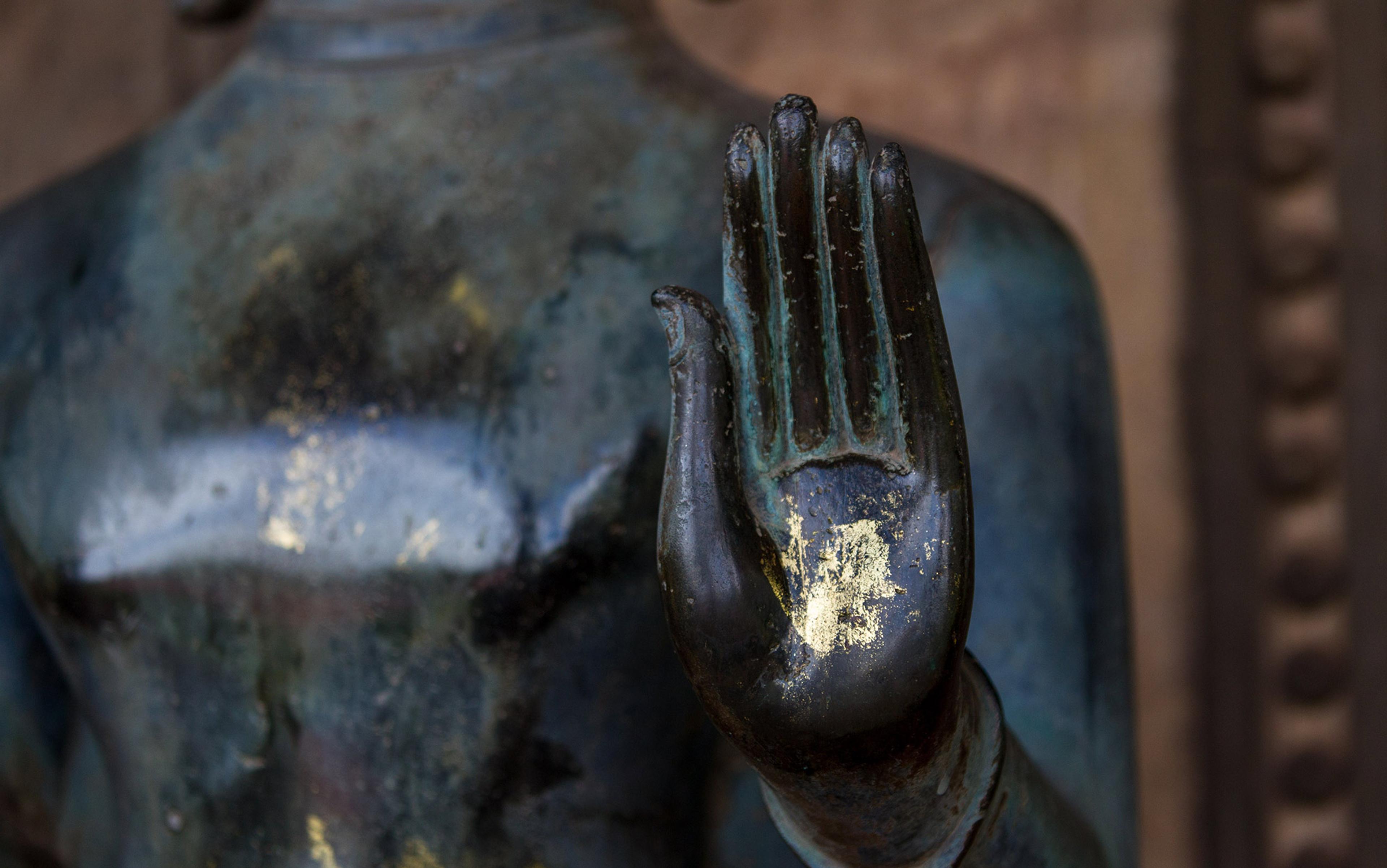Three years ago, when I was studying for a Masters in Philosophy at the University of Cambridge, mindfulness was very much in the air. The Department of Psychiatry had launched a large-scale study on the effects of mindfulness in collaboration with the university’s counselling service. Everyone I knew seemed to be involved in some way: either they were attending regular mindfulness classes and dutifully filling out surveys or, like me, they were part of a control group who didn’t attend classes, but found themselves caught up in the craze even so. We gathered in strangers’ houses to meditate at odd hours, and avidly discussed our meditative experiences. It was a strange time.
Raised as a Buddhist in New Zealand and Sri Lanka, I have a long history with meditation – although, like many ‘cultural Catholics’, my involvement was often superficial. I was crushingly bored whenever my parents dragged me to the temple as a child. At university, however, I turned to psychotherapy to cope with the stress of the academic environment. Unsurprisingly, I found myself drawn to schools or approaches marked by the influence of Buddhist philosophy and meditation, one of which was mindfulness. Over the years, before and during the Cambridge trial, therapists have taught me an arsenal of mindfulness techniques. I have been instructed to observe my breath, to scan my body and note the range of its sensations, and to observe the play of thoughts and emotions in my mind. This last exercise often involves visual imagery, where a person is asked to consider thoughts and feelings in terms of clouds in the sky or leaves drifting in a river. A popular activity (though I’ve never tried it myself) even involves eating a raisin mindfully, where you carefully observe the sensory experience from start to finish, including changes in texture and the different tastes and smells.
At the end of the Cambridge study, I found myself to be calmer, more relaxed and better able to step away from any overwhelming feelings. My experience was mirrored in the research findings, which concluded that regular mindfulness meditation reduces stress levels and builds resilience. Yet I’d also become troubled by a cluster of feelings that I couldn’t quite identify. It was as if I could no longer make sense of my emotions and thoughts. Did I think the essay I’d just written was bad because the argument didn’t quite work, or was I simply anxious about the looming deadline? Why did I feel so inadequate? Was it imposter syndrome, depression or was I just not a good fit for this kind of research? I couldn’t tell whether I had particular thoughts and feelings simply because I was stressed and inclined to give in to melodramatic thoughts, or because there was a good reason to think and feel those things. Something about the mindfulness practice I’d cultivated, and the way it encouraged me to engage with my emotions, made me feel increasingly estranged from myself and my life.
In the intervening years, I’ve obsessed over this experience – to the point that I left a PhD in an entirely different area of philosophy and put myself through the gruelling process of reapplying for graduate programmes, just so I could understand what had happened. I began following a thread from ancient Buddhist texts to more recent books on meditation to see how ideas have migrated to the contemporary mindfulness movement. What I’ve uncovered has disturbing implications for how mindfulness encourages us to relate to our thoughts, emotions and very sense of self.
Where once Europeans and North Americans might have turned to religion or philosophy to understand themselves, increasingly they are embracing psychotherapy and its cousins. The mindfulness movement is a prominent example of this shift in cultural habits of self-reflection and interrogation. Instead of engaging in deliberation about oneself, what the arts of mindfulness have in common is a certain mode of attending to present events – often described as a ‘nonjudgmental awareness of the present moment’. Practitioners are discouraged from engaging with their experiences in a critical or evaluative manner, and often they’re explicitly instructed to disregard the content of their own thoughts.
When eating the raisin, for example, the focus is on the process of consuming it, rather than reflecting on whether you like raisins or recalling the little red boxes of them you had in your school lunches, and so on. Similarly, when focusing on your breath or scanning your body, you should concentrate on the activity, rather than following the train of your thoughts or giving in to feelings of boredom and frustration. The goal is not to end up thinking or feeling nothing, but rather to note whatever arises, and to let it pass with the same lightness.
One reason that mindfulness finds such an eager audience is that it garbs itself in a mantle of value-neutrality. In his book Wherever You Go (1994), Jon Kabat-Zinn, a founding father of the contemporary mindfulness movement, claims that mindfulness ‘will not conflict with any beliefs … – religious or for that matter scientific – nor is it trying to sell you anything, especially not a belief system or ideology’. As well as relieving stress, Kabat-Zinn and his followers claim that mindfulness practices can help with alleviating physical pain, treat mental illness, boost productivity and creativity, and help us understand our ‘true’ selves. Mindfulness has become something of a one-size-fits-all response for a host of modern ills – something ideologically innocent that fits easily into anyone’s life, regardless of background, beliefs or values.
Commodification has produced watered-down versions – available via apps, and taught in schools and offices
Yet mindfulness is not without its critics. The way in which it relates to Buddhism, particularly its meditation practices, is an ongoing area of controversy. Buddhist scholars have accused the contemporary mindfulness movement of everything from misrepresenting Buddhism to cultural appropriation. Kabat-Zinn has muddied the waters further by claiming that mindfulness demonstrates the truth of key Buddhist doctrines. But critics say that the nonjudgmental aspects of mindfulness are in fact at odds with Buddhist meditation, in which individuals are instructed to actively evaluate and engage with their experiences in light of Buddhist doctrine.
Others point out that the goals of psychotherapy and mindfulness do not match up with core Buddhist tenets: while psychotherapy might attempt to reduce suffering, for example, Buddhism takes it to be so deeply entrenched that one should aim to escape the miserable cycle of rebirth altogether. A third line of attack can be summed up in the epithet ‘McMindfulness’. Critics such as the author David Forbes and the management professor Ronald Purser argue that, as mindfulness has moved from therapy to the mainstream, commodification and marketing have produced watered-down, corrupted versions – available via apps such as Headspace and Calm, and taught as courses in schools, universities and offices.
My own gripes with mindfulness are of a different, though related, order. In claiming to offer a multipurpose, multi-user remedy for all occasions, mindfulness oversimplifies the difficult business of understanding oneself. It fits oh-so-neatly into a culture of techno-fixes, easy answers and self-hacks, where we can all just tinker with the contents of our heads to solve problems, instead of probing why we’re so dissatisfied with our lives in the first place. As I found with my own experience, though, it’s not enough to simply watch one’s thoughts and feelings. To understand why mindfulness is uniquely unsuited for the project of real self-understanding, we need to probe the suppressed assumptions about the self that are embedded in its foundations.
Contrary to Kabat-Zinn’s loftier claims to universalism, mindfulness is in fact ‘metaphysically loaded’: it relies on its practitioners signing up to positions they might not readily accept. In particular, mindfulness is grounded in the Buddhist doctrine of anattā, or the ‘no-self’. Anattā is a metaphysical denial of the self, defending the idea that there is nothing like a soul, spirit or any ongoing individual basis for identity. This view denies that each of us is an underlying subject of our own experience. By contrast, Western metaphysics typically holds that – in addition to the existence of any thoughts, emotions and physical sensations – there is some entity to whom all these experiences are happening, and that it makes sense to refer to this entity as ‘I’ or ‘me’. However, according to Buddhist philosophy, there is no ‘self’ or ‘me’ to which such phenomena belong.
It’s striking how much shared terrain there is among the strategies that Buddhists use to reveal the ‘truth’ of anattā, and the exercises of mindfulness practitioners. One technique in Buddhism, for example, involves examining thoughts, feelings and physical sensations, and noting that they are impermanent, both individually and collectively. Our thoughts and emotions change rapidly, and physical sensations come and go in response to stimuli. As such (the thinking goes), they cannot be the entity that persists throughout a lifetime – and, whatever the self is, it cannot be as ephemeral and short-lived as these phenomena. Nor can the self be these phenomena collectively as they are all equally impermanent. But then, the Buddhists point out, there is also nothing besides these phenomena that could be the self. Consequently, there is no self. From the realisation of impermanence, you gain the additional insight that these phenomena are impersonal; if there is no such thing as ‘me’, to whom transitory phenomena such as thoughts can be said to belong, then there’s no sense in which these thoughts are ‘mine’.
Like their Buddhist predecessors, contemporary mindfulness practitioners stress these qualities of impermanence and impersonality. Exercises repeatedly draw attention to the transitory nature of what is being observed in the present moment. Explicit directions (‘see how thoughts seem to simply arise and cease’) and visual imagery (‘think of your thoughts like clouds drifting away in the sky’) reinforce ideas of transience, and encourage us to detach ourselves from getting too caught up in our own experience (‘You are not your thoughts; you are not your pain’ are common mantras).
After a certain point, mindfulness doesn’t allow you to take responsibility for and analyse your feelings
I put my earlier sense of self-estrangement and disorientation down to mindfulness’s close relationship with anattā. With the no-self doctrine, we relinquish not only more familiar understandings of the self, but also the idea that mental phenomena such as thoughts and feelings are our own. In doing so, we make it harder to understand why we think and feel the way we do, and to tell a broader story about ourselves and our lives. The desire for self-understanding tends to be tied up with the belief that there is something to be understood – not necessarily in terms of some metaphysical substrate, but a more commonplace, persisting entity, such as one’s character or personality. We don’t tend to think that thoughts and feelings are disconnected, transitory events that just happen to occur in our minds. Rather, we see them as belonging to us because they are reflective of us in some way. People who worry that they are neurotic, for example, will probably do so based on their repeated feelings of insecurity and anxiety, and their tendency towards nitpicking. They will recognise these feelings as flowing from the fact that they might have a particular personality or character trait.
Of course, it’s often pragmatically useful to step away from your own fraught ruminations and emotions. Seeing them as drifting leaves can help us gain a certain distance from the heat of our feelings, so as to discern patterns and identify triggers. But after a certain point, mindfulness doesn’t allow you to take responsibility for and analyse such feelings. It’s not much help in sifting through competing explanations for why you might be thinking or feeling a certain way. Nor can it clarify what these thoughts and feelings might reveal about your character. Mindfulness, grounded in anattā, can offer only the platitude: ‘I am not my feelings.’ Its conceptual toolbox doesn’t allow for more confronting statements, such as ‘I am feeling insecure,’ ‘These are my anxious feelings,’ or even ‘I might be a neurotic person.’ Without some ownership of one’s feelings and thoughts, it is difficult to take responsibility for them. The relationship between individuals and their mental phenomena is a weighty one, encompassing questions of personal responsibility and history. These matters shouldn’t be shunted so easily to one side.
As well as severing the relationship between you and your thoughts and feelings, mindfulness makes self-understanding difficult in another way. By relinquishing the self, we divorce it from its environment and therefore its particular explanatory context. As I write this, I’ve spent the past month being fairly miserable. If I were being mindful, I would note that there were emotions of sadness and helplessness as well as anxious thoughts. While mindfulness might indirectly help me glean something about the recurring content of my thoughts, without some idea of a self, separate from but embedded in a social context, I couldn’t gain much further insight. Trails of thought and feeling, on their own, give us no way of telling whether we’re reacting disproportionately to some small event in our lives, or, as I was, responding appropriately to recent tragic events.
To look for richer explanations about why you think and feel the way you do, you need to see yourself as a distinct individual, operating within a certain context. You need to have some account of the self, as this demarcates what is a response to your context, and what flows from yourself. I know I have a propensity towards neurotic worrying and overthinking. Thinking of myself as an individual in a particular context is what allows me to identify whether the source of these worries stems from my internal character traits or if I am simply responding to an external situation. Often the answer is a mixture of both, but even this ambiguity requires a careful scrutiny, not only of thoughts and feelings but the specific context in which they arose.
The problem is the tendency to present mindfulness as a panacea for all manner of modern ills
The contrasting tendency in mindfulness to bracket context not only cramps self-understanding. It also renders our mental challenges dangerously apolitical. In spite of a growing literature probing the root causes of mental-health issues, policymakers tend to rely on low-cost, supposedly all-encompassing solutions for a broad base of clients. The focus tends to be solely on the contents of an individual’s mind and the alleviation of their distress, rather than on interrogating the deeper socioeconomic and political conditions that give rise to the distress in the first place. Older people tend to suffer high rates of depression, for example, but that’s usually addressed via pharmaceutical or therapeutic means – instead of considering, say, social isolation or financial pressures. Mindfulness follows the trend for simplicity and individuation. Its embedded assumptions about the self make it particularly prone to neglecting broader considerations, since they allow for no notion of individuals as enmeshed in and affected by society at large.
I don’t mean to suggest that everyone who does mindfulness will feel estranged from their thoughts the way I did, nor that it will inevitably restrict their capacity to understand themselves. It can be a useful tool in helping us gain some distance from the tumult of our inner experience. The problem is the current tendency to present mindfulness as a wholesale remedy, a panacea for all manner of modern ills.
I still dabble in mindfulness, but these days I tend to draw on it sparingly. I might do a mindfulness meditation when I’ve had a difficult day at work, or if I’m having trouble sleeping, rather than keeping up a regular practice. With its promises of assisting everyone with anything and everything, the mistake of the mindfulness movement is to present its impersonal mode of awareness as a superior or universally useful one. Its roots in the Buddhist doctrine of anattā mean that it sidelines a certain kind of deep, deliberative reflection that’s required for unpicking which of our thoughts and emotions are reflective of ourselves, which are responses to the environment, and – the most difficult question of all – what we should be doing about it.






